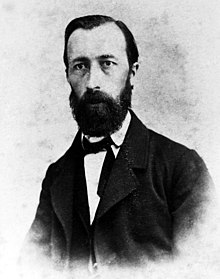Friedrich Belthle
Christian Friedrich Belthle (born February 27, 1829 in Bebenhausen ; † May 9, 1869 in Wetzlar) was a German optician and microscope manufacturer in Wetzlar. As head of the local "Optical Institute" he was successor to Carl Kellner and predecessor of Ernst Leitz I .
Belthle was employed in Kellner's workshop from February 8th to April 28th, 1855 and after Kellner's death on May 13th as a mechanic's assistant again from June 20th. On December 6, 1855, he married Kellner's widow. Then the workshop manager appointed by Kellner, Ludwig Engelbert, left the company and Belthle took over on his wife's account. Ernst Leitz joined the workshop in January 1864 and became a partner in 1865, but Belthle managed the workshop until his death, i.e. for more than 13 years. During this time he had an average of nine assistants and an average of 60 to 70 microscopes were produced per year.
- Belthle microscopes. From Dippel, 1867.
The devices of the predecessor Carl Kellner had received the highest recognition in scientific circles. Contemporaries described the mechanical parts of those from Belthle, the so-called brass work, as “more excellent” than those from Kellner, but the optical quality was assessed differently; by “almost the same as the best waiters” and “... excellent for the finer histological examinations ... not surpassed by any of the equally strong newer systems” to “are decidedly inferior to those of its predecessor in terms of sharpness and clarity of the image”.
Despite the good quality of the microscopes, Belthle ran into financial difficulties. From 1857 to 1861, Heinrich Friedrich Rexroth from Umstadt became a partner, the company was called 'Belthle und Rexroth, formerly Carl Kellner' at that time. Another donor was Moritz Heertz, a banker in Wetzlar. After Rexroth left the company, Rexroth manufactured telegraphic systems and operated the telegraphic station in Wetzlar until it became state-owned in 1872.
In 1866 the workshop produced the record number of 160 microscopes, the annual turnover was 5960 thalers. In 1867 the thousandth microscope left the workshop. After that, however, sales collapsed. In 1869, the year Belthle died, it was only 2,434 thalers. Three reasons are cited as the cause: Belthle's long lung disease, from which he finally died, marital problems and sticking to Kellner's designs while the technical possibilities and thus the market continued to develop. In contrast to its competitors, Belthle was not ready to take over the horseshoe tripod developed by Georg Oberhäuser , so that the competition from his successor Edmund Hartnack increasingly had an impact.
literature
- Alfons Renz / Claus Walter: Christian Friedrich Belthle. Co-founder of the Leitz works in Wetzlar. In. In: Karlheinz Wiegmann (Ed.): There and away. Tübingen all over the world, Kulturamt, Tübingen 2007 (Tübingen catalogs, volume 77), pp. 25–35, ISBN 978-3-910090-77-4 .
Web links
- Small microscope from Ms. Belthle in Wetzlar in the "Museum of Optical Instruments".
Individual evidence
- ↑ a b c Dieter Gerlach: History of microscopy . Verlag Harri Deutsch, Frankfurt am Main 2009, ISBN 978-3-8171-1781-9 , pp. 364-366 .
- ↑ Dr. Leopold Dippel: The microscope and its application . Friedrich Vieweg and son, Braunschweig 1867, p. 149-151 .
- ↑ Hermann Welcker: About the storage of microscopic objects . Giessen 1856, p. 40 . , quoted from Harting, 1859
- ↑ Dr. Leopold Dippel: The microscope and its application . Friedrich Vieweg and son, Braunschweig 1867, p. 153 .
- ↑ Harting: The microscope. Theory, Uses, History and Present State of the same. Volume 3 . 2nd Edition. Friedrich Vieweg and son, Braunschweig 1866, p. 191 .
| personal data | |
|---|---|
| SURNAME | Belthle, Friedrich |
| ALTERNATIVE NAMES | Belthle, Christian Friedrich (full name) |
| BRIEF DESCRIPTION | German optician and microscope manufacturer in Wetzlar |
| DATE OF BIRTH | February 27, 1829 |
| PLACE OF BIRTH | Bebenhausen |
| DATE OF DEATH | May 9, 1869 |
| Place of death | Wetzlar |



